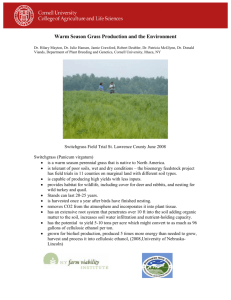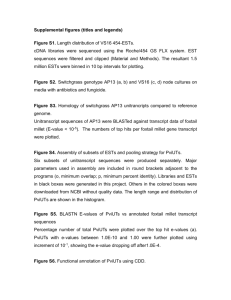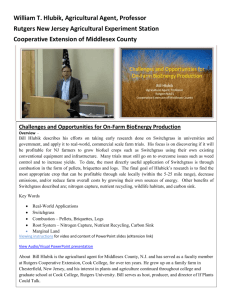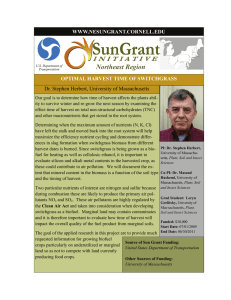SWITCHGRASS
advertisement
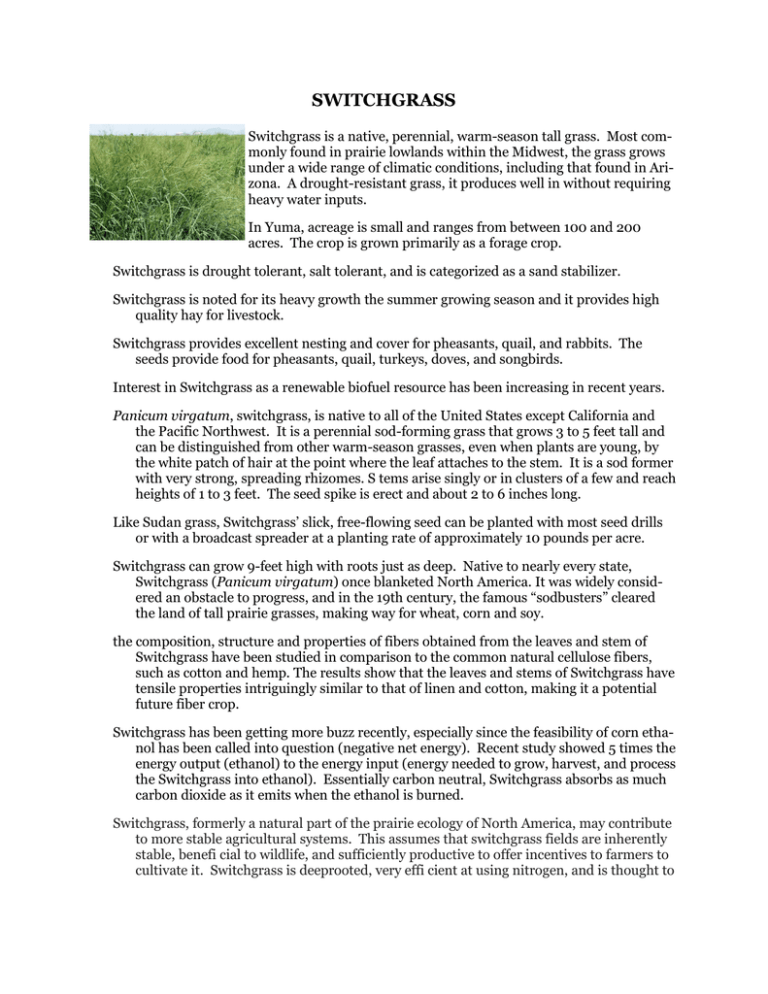
SWITCHGRASS Switchgrass is a native, perennial, warm-season tall grass. Most commonly found in prairie lowlands within the Midwest, the grass grows under a wide range of climatic conditions, including that found in Arizona. A drought-resistant grass, it produces well in without requiring heavy water inputs. In Yuma, acreage is small and ranges from between 100 and 200 acres. The crop is grown primarily as a forage crop. Switchgrass is drought tolerant, salt tolerant, and is categorized as a sand stabilizer. Switchgrass is noted for its heavy growth the summer growing season and it provides high quality hay for livestock. Switchgrass provides excellent nesting and cover for pheasants, quail, and rabbits. The seeds provide food for pheasants, quail, turkeys, doves, and songbirds. Interest in Switchgrass as a renewable biofuel resource has been increasing in recent years. Panicum virgatum, switchgrass, is native to all of the United States except California and the Pacific Northwest. It is a perennial sod-forming grass that grows 3 to 5 feet tall and can be distinguished from other warm-season grasses, even when plants are young, by the white patch of hair at the point where the leaf attaches to the stem. It is a sod former with very strong, spreading rhizomes. S tems arise singly or in clusters of a few and reach heights of 1 to 3 feet. The seed spike is erect and about 2 to 6 inches long. Like Sudan grass, Switchgrass’ slick, free-flowing seed can be planted with most seed drills or with a broadcast spreader at a planting rate of approximately 10 pounds per acre. Switchgrass can grow 9-feet high with roots just as deep. Native to nearly every state, Switchgrass (Panicum virgatum) once blanketed North America. It was widely considered an obstacle to progress, and in the 19th century, the famous “sodbusters” cleared the land of tall prairie grasses, making way for wheat, corn and soy. the composition, structure and properties of fibers obtained from the leaves and stem of Switchgrass have been studied in comparison to the common natural cellulose fibers, such as cotton and hemp. The results show that the leaves and stems of Switchgrass have tensile properties intriguingly similar to that of linen and cotton, making it a potential future fiber crop. Switchgrass has been getting more buzz recently, especially since the feasibility of corn ethanol has been called into question (negative net energy). Recent study showed 5 times the energy output (ethanol) to the energy input (energy needed to grow, harvest, and process the Switchgrass into ethanol). Essentially carbon neutral, Switchgrass absorbs as much carbon dioxide as it emits when the ethanol is burned. Switchgrass, formerly a natural part of the prairie ecology of North America, may contribute to more stable agricultural systems. This assumes that switchgrass fields are inherently stable, benefi cial to wildlife, and sufficiently productive to offer incentives to farmers to cultivate it. Switchgrass is deeprooted, very effi cient at using nitrogen, and is thought to maintain a symbiotic or beneficial relationship with microscopic soil fungi, which make soil nutrients available to the extensive Switchgrass root system. Switchgrass makes a good forage crop, and many people encourage its growth to feed cattle or horses. It is sometimes grown in order to be harvested and turned into pellets to be used as a feed supplement for livestock . It also provides an easy habitat for a number of ground birds, and so is often used to help reclaim wildlife areas. Because of its adaptability, fast growth, and drought-resistant nature, Switchgrass has recently been mentioned on numerous occasions as a likely candidate for a nation-wide fuel crop. In his 2006 State of the Union address, President Bush mentioned Switchgrass in the context of being used for ethanol production to help wean the United States from its dependence on foreign oil. Kurt Nolte is an area agriculture agent with the Yuma County Cooperative Extension. He can be reached at 928-726-3904.
